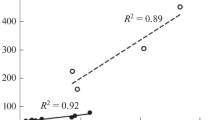Abstract
The well-known elastic polymeric material polyether urethane urea SKU-PFL, which is a typical segmented block copolymer, was chosen as an object of study. Powdered microdispersed fillers capable of improving wear resistance were added to this material at the manufacturing stage in different amounts (up to 1.5 wt %): calcium stearate and molybdenum disulfide. The found level of the optimal filler concentration for the studied elastomers in the region close to 0.5 wt % makes it possible to consider calcium stearate and molybdenum disulfide as not only effective, but also economical, components of promising wear-resistant polymeric materials.


Similar content being viewed by others
REFERENCES
I. Yilgör, E. Yilgör, and G. L. Wilkes, “Critical parameters in designing segmented polyurethanes and their effect on morphology and properties: A comprehensive review,” Polymer 58, 1–36 (2015).
M. F. Sonnenschein, Polyurethanes: Science, Technology, Markets, and Trends (John Wiley & Sons, New York, 2014).
S. V. Portnov, L. V. Podkol’zina, and S. N. Yakovlev, “Main types of wear of modern structural polyurethanes,” Sb. Mashinostr. Priborostr., No. 12, 40–44 (2016).
Y. Fukahori, P. Gabriel, H. Liang, and J. J. C. Busfield, “A new generalized philosophy and theory for rubber friction and wear,” Wear 446–447, 203166 (2020).
A. Abdelbary, Wear of Polymers and Composites (Woodhead Publ., Amsterdam, 2015).
Y. Fukahori and H. Yamazaki, “Mechanism of rubber abrasion: How is friction linked to fracture in rubber abrasion?,” Wear 188 (1–2), 19–26 (1995).
S. Xiao, K. A. Laux, H. Wang, F. Hu, and H. J. Sue, “Physical correlation between abrasive wear performance and scratch resistance in model polyurethane elastomers,” Wear 418, 281–289 (2019).
V. Y. Senichev and E. V. Pogoreltsev, “The relationship between abrasive wear behavior and chemical structure of polyurethane urea elastomers,” J. Phys.: Conf. Ser. 1399, 044006 (2019).
S. N. Yakovlev, “Experimental determination of the coefficient of sliding friction of polyurethane on an abrasive surface,” Vopr. Materialoved., No. 2, 123–131 (2015).
E. R. Volkova, “Composite materials based on segmented polyurethane and microdispersed mineral filler,” Perspekt. Mater., No. 11, 53–58 (2013).
E. R. Volkova, “Effect of the nature and concentration of the filler on the properties of polyurethane composites used in water,” Perspekt. Mater., No. 4, 37–42 (2014).
S. V. Panin, L. A. Kornienko, T. Nguen Suan, L. R. Ivanova, M. A. Poltaranin, and S. V. Shil’ko, “Wear resistance of composites based on ultrahigh molecular weight polyethylene filled with graphite and molybdenum disulfide microparticles,” J. Frict. Wear 35, 290–296 (2014). https://doi.org/10.3103/S1068366614040084
S. V. Panin, L. A. Kornienko, T. Nguen Suan, L. R. Ivanova, M. A. Poltaranin, S. V. Shil’ko, and Yu. M. Pleskachevskii, “Wear resistance of solid lubricant composites based on ultra-high molecular weight polyethylene modified with calcium stearate,” Mater., Tekhnol., Instrum. 20 (1), 8–15 (2015).
Yu. K. Mashkov, O. A. Kurguzova, and A. S. Ruban, “Development and research of wear-resistant polymer nanocomposites,” Vestn. Sib. Gos. Avtomob.-Dorozhn. Akad. 15 (1), 36–45 (2018).
A. A. Semenets and A. N. Anisimov, “Development of triboengineering composite materials based on thermoplastic polyurethanes,” J. Frict. Wear 31, 208–213 (2010). https://doi.org/10.3103/S1068366610030098
A. S. Zabolotnov, P. N. Brevnov, V. V. Akul’shin, L. A. Novokshonova, F. A. Doronin, A. G. Evdokimov, and V. G. Nazarov, “Wear resistance of composite materials based on ultra-high molecular weight polyethylene with fillers of different types,” Vse Mater., Entsikl. Sprav., No. 12, 13–19 (2017).
Funding
The study was performed using the equipment of the Center for Shared Use “Studies of Materials and Substance,” Perm Federal Research Center, Ural Branch, Russian Academy of Sciences, and budget funds within the framework of the state assignment for Institute of Technical Chemistry, Ural Branch, Russian Academy of Sciences (State Registration Number of the Topic АААА-А18-118022290056-8).
Author information
Authors and Affiliations
Corresponding author
Additional information
Translated by Sh. Galyaltdinov
Rights and permissions
About this article
Cite this article
Senichev, V.Y., Pogorel’tsev, E.V., Makarova, M.A. et al. The Influence of Fillers on Abrasive Wear of Segmented Polyurethane Urea. Polym. Sci. Ser. D 14, 467–469 (2021). https://doi.org/10.1134/S199542122103028X
Received:
Revised:
Accepted:
Published:
Issue Date:
DOI: https://doi.org/10.1134/S199542122103028X



